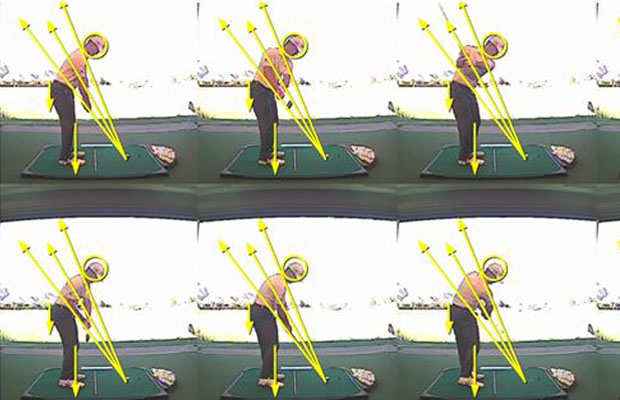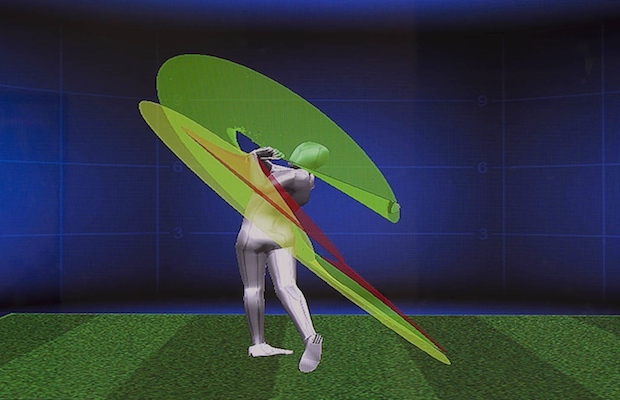Instruction
Using Trackman has made me LESS technical as a teacher

Early in my teaching career, I was told that in order to a successful instructor I had to have great communication skills and possess a talent to describe a highly complex motion in an understandable way to my students. In the 20 years that I’ve been teaching golf, the technologies that instructors now have available to them have only made that lesson more important.
My goal for the swing and its “repair” is to make it as simple as possible for the golfers to understand, whether it is in the articles I write or the lessons I give to my clients. The goal of every teacher is to bridge the gap between giving the student too much information and just the right amount.
With the advent of systems like Trackman and FlightScope, golf instructors are now armed with an enormous amount of data to help them understand what is happening to the Nth degree. While having this information at our fingertips is awesome, it can also cause problems for less experienced teachers. I know from experience that whenever I have more data on hand, it can be very easy to give golfers more information than what is necessary. However, I will tell you that when a teacher truly understands the correlations within the data, it can help instructors make their lessons less technical than ever.
With anything new, there is always a learning curve. But over time, anyone who studies can learn to dissect all the data and assimilate it into his or her teaching style. People tend to criticize what they don’t understand, and using the latest technology will test you in the beginning. But I promise, once you have the “aha” moment, you will be on your way to doing things on the lesson tee in a much more efficient way than ever before.
Years ago, when there was only video, teachers tended to become too position focused, and I think that has carried over to the current crop of young teachers using club and ball flight analyzers. They tend to focus only on pleasing the machine, and sometimes try to force their students into achieving the perfect numbers associated with tour players. While it’s nice to try and copy what better do, it is not the ONLY way a golfer can be successful. Using club and ball flight analyzers in this manner will easily boggle the minds of even the smartest of students.
Above: Justin Rose uses video and Trackman to improve his swing with instructor Sean Foley.
So how do you use club and ball flight analyzers in the best way possible?
In the past, I was overcritical of positions that I thought I saw on camera that might influence factors like the club’s swing direction or the club’s face angle at impact. Now that I can actually see the club’s true path and the face-to-path relationship, I have found myself less focused on what things look like and more focused on what the swing actually produces consistently from the stroke pattern side. No longer do I obsess over things like a student “picking up the club” on the backswing if the downstroke plane is within certain parameters at impact. Often, when I let golfers have some freedom to do what it is natural to them, they achieve a “fix” that is much easier to implement in both the short and long term. There are exceptions to the rules, but generally if I see a decent player whose path and face are under control to some consistent degree, I’m not overly concerned how they got there.
So what do I do if golfer’s angle of attack is a touch down with the driver? As long as the player produces ample distance for the desired level of play and has adequate ball control from side to side, then the player will be fine. What some teachers forget is that the numbers only support or refute what the player is feeling, and are there to give the teacher feedback while making a swing change. The more I understand the data, the better I will get at fixing the one thing that will affect the other seven categories that are a touch off. Find the cause and the effects will take care of themselves.
Over time, instructors will find that they are not so worried about idiosyncrasies shown on video, but more focused on the one simple piece of the “data pie” that will fix it all. From there, it is all about how the player can improve his path, angle of attack, dynamic loft or whatever you as the teacher decide is in the student’s own best way. The best teachers use Trackman or FlightScope in a way that helps players learn through self-discovery. They don’t try to fix every single data point individually, because that makes things way too complicated.
Teachers need video in order to audit positions. They also need club and ball flight analyzers in order to audit the things they cannot see with video. The secret is putting the two mediums together to offer a “fix” for each student regardless of ability level. Use technology to fix the causes, not the effects of a golfer’s swing, and I bet that your students will play better and look forward to more lessons.
Read More Tom Stickney II : What Flightscope and Trackman can tell you (and me)
Instruction
The Wedge Guy: Beating the yips into submission

There may be no more painful affliction in golf than the “yips” – those uncontrollable and maddening little nervous twitches that prevent you from making a decent stroke on short putts. If you’ve never had them, consider yourself very fortunate (or possibly just very young). But I can assure you that when your most treacherous and feared golf shot is not the 195 yard approach over water with a quartering headwind…not the extra tight fairway with water left and sand right…not the soft bunker shot to a downhill pin with water on the other side…No, when your most feared shot is the remaining 2- 4-foot putt after hitting a great approach, recovery or lag putt, it makes the game almost painful.
And I’ve been fighting the yips (again) for a while now. It’s a recurring nightmare that has haunted me most of my adult life. I even had the yips when I was in my 20s, but I’ve beat them into submission off and on most of my adult life. But just recently, that nasty virus came to life once again. My lag putting has been very good, but when I get over one of those “you should make this” length putts, the entire nervous system seems to go haywire. I make great practice strokes, and then the most pitiful short-stroke or jab at the ball you can imagine. Sheesh.
But I’m a traditionalist, and do not look toward the long putter, belly putter, cross-hand, claw or other variation as the solution. My approach is to beat those damn yips into submission some other way. Here’s what I’m doing that is working pretty well, and I offer it to all of you who might have a similar affliction on the greens.
When you are over a short putt, forget the practice strokes…you want your natural eye-hand coordination to be unhindered by mechanics. Address your putt and take a good look at the hole, and back to the putter to ensure good alignment. Lighten your right hand grip on the putter and make sure that only the fingertips are in contact with the grip, to prevent you from getting to tight.
Then, take a long, long look at the hole to fill your entire mind and senses with the target. When you bring your head/eyes back to the ball, try to make a smooth, immediate move right into your backstroke — not even a second pause — and then let your hands and putter track right back together right back to where you were looking — the HOLE! Seeing the putter make contact with the ball, preferably even the forward edge of the ball – the side near the hole.
For me, this is working, but I am asking all of you to chime in with your own “home remedies” for the most aggravating and senseless of all golf maladies. It never hurts to have more to fall back on!
Instruction
Looking for a good golf instructor? Use this checklist

Over the last couple of decades, golf has become much more science-based. We measure swing speed, smash factor, angle of attack, strokes gained, and many other metrics that can really help golfers improve. But I often wonder if the advancement of golf’s “hard” sciences comes at the expense of the “soft” sciences.
Take, for example, golf instruction. Good golf instruction requires understanding swing mechanics and ball flight. But let’s take that as a given for PGA instructors. The other factors that make an instructor effective can be evaluated by social science, rather than launch monitors.
If you are a recreational golfer looking for a golf instructor, here are my top three points to consider.
1. Cultural mindset
What is “cultural mindset? To social scientists, it means whether a culture of genius or a culture of learning exists. In a golf instruction context, that may mean whether the teacher communicates a message that golf ability is something innate (you either have it or you don’t), or whether golf ability is something that can be learned. You want the latter!
It may sound obvious to suggest that you find a golf instructor who thinks you can improve, but my research suggests that it isn’t a given. In a large sample study of golf instructors, I found that when it came to recreational golfers, there was a wide range of belief systems. Some instructors strongly believed recreational golfers could improve through lessons. while others strongly believed they could not. And those beliefs manifested in the instructor’s feedback given to a student and the culture created for players.
2. Coping and self-modeling can beat role-modeling
Swing analysis technology is often preloaded with swings of PGA and LPGA Tour players. The swings of elite players are intended to be used for comparative purposes with golfers taking lessons. What social science tells us is that for novice and non-expert golfers, comparing swings to tour professionals can have the opposite effect of that intended. If you fit into the novice or non-expert category of golfer, you will learn more and be more motivated to change if you see yourself making a ‘better’ swing (self-modeling) or seeing your swing compared to a similar other (a coping model). Stay away from instructors who want to compare your swing with that of a tour player.
3. Learning theory basics
It is not a sexy selling point, but learning is a process, and that process is incremental – particularly for recreational adult players. Social science helps us understand this element of golf instruction. A good instructor will take learning slowly. He or she will give you just about enough information that challenges you, but is still manageable. The artful instructor will take time to decide what that one or two learning points are before jumping in to make full-scale swing changes. If the instructor moves too fast, you will probably leave the lesson with an arm’s length of swing thoughts and not really know which to focus on.
As an instructor, I develop a priority list of changes I want to make in a player’s technique. We then patiently and gradually work through that list. Beware of instructors who give you more than you can chew.
So if you are in the market for golf instruction, I encourage you to look beyond the X’s and O’s to find the right match!
Instruction
What Lottie Woad’s stunning debut win teaches every golfer

Most pros take months, even years, to win their first tournament. Lottie Woad needed exactly four days.
The 21-year-old from Surrey shot 21-under 267 at Dundonald Links to win the ISPS Handa Women’s Scottish Open by three shots — in her very first event as a professional. She’s only the third player in LPGA history to accomplish this feat, joining Rose Zhang (2023) and Beverly Hanson (1951).
But here’s what caught my attention as a coach: Woad didn’t win through miraculous putting or bombing 300-yard drives. She won through relentless precision and unshakeable composure. After watching her performance unfold, I’m convinced every golfer — from weekend warriors to scratch players — can steal pages from her playbook.
Precision Beats Power (And It’s Not Even Close)
Forget the driving contests. Woad proved that finding greens matters more than finding distance.
What Woad did:
• Hit it straight, hit it solid, give yourself chances
• Aimed for the fat parts of greens instead of chasing pins
• Let her putting do the talking after hitting safe targets
• As she said, “Everyone was chasing me today, and managed to maintain the lead and played really nicely down the stretch and hit a lot of good shots”
Why most golfers mess this up:
• They see a pin tucked behind a bunker and grab one more club to “go right at it”
• Distance becomes more important than accuracy
• They try to be heroic instead of smart
ACTION ITEM: For your next 10 rounds, aim for the center of every green regardless of pin position. Track your greens in regulation and watch your scores drop before your swing changes.
The Putter That Stayed Cool Under Fire
Woad started the final round two shots clear and immediately applied pressure with birdies at the 2nd and 3rd holes. When South Korea’s Hyo Joo Kim mounted a charge and reached 20-under with a birdie at the 14th, Woad didn’t panic.
How she responded to pressure:
• Fired back with consecutive birdies at the 13th and 14th
• Watched Kim stumble with back-to-back bogeys
• Capped it with her fifth birdie of the day at the par-5 18th
• Stayed patient when others pressed, pressed when others cracked
What amateurs do wrong:
• Get conservative when they should be aggressive
• Try to force magic when steady play would win
• Panic when someone else makes a move
ACTION ITEM: Practice your 3-6 foot putts for 15 minutes after every range session. Woad’s putting wasn’t spectacular—it was reliable. Make the putts you should make.
Course Management 101: Play Your Game, Not the Course’s Game
Woad admitted she couldn’t see many scoreboards during the final round, but it didn’t matter. She stuck to her game plan regardless of what others were doing.
Her mental approach:
• Focused on her process, not the competition
• Drew on past pressure situations (Augusta National Women’s Amateur win)
• As she said, “That was the biggest tournament I played in at the time and was kind of my big win. So definitely felt the pressure of it more there, and I felt like all those experiences helped me with this”
Her physical execution:
• 270-yard drives (nothing flashy)
• Methodical iron play
• Steady putting
• Everything effective, nothing spectacular
ACTION ITEM: Create a yardage book for your home course. Know your distances to every pin, every hazard, every landing area. Stick to your plan no matter what your playing partners are doing.
Mental Toughness Isn’t Born, It’s Built
The most impressive part of Woad’s win? She genuinely didn’t expect it: “I definitely wasn’t expecting to win my first event as a pro, but I knew I was playing well, and I was hoping to contend.”
Her winning mindset:
• Didn’t put winning pressure on herself
• Focused on playing well and contending
• Made winning a byproduct of a good process
• Built confidence through recent experiences:
- Won the Women’s Irish Open as an amateur
- Missed a playoff by one shot at the Evian Championship
- Each experience prepared her for the next
What this means for you:
• Stop trying to shoot career rounds every time you tee up
• Focus on executing your pre-shot routine
• Commit to every shot
• Stay present in the moment
ACTION ITEM: Before each round, set process goals instead of score goals. Example: “I will take three practice swings before every shot” or “I will pick a specific target for every shot.” Let your score be the result, not the focus.
The Real Lesson
Woad collected $300,000 for her first professional victory, but the real prize was proving that fundamentals still work at golf’s highest level. She didn’t reinvent the game — she simply executed the basics better than everyone else that week.
The fundamentals that won:
• Hit more fairways
• Find more greens
• Make the putts you should make
• Stay patient under pressure
That’s something every golfer can do, regardless of handicap. Lottie Woad just showed us it’s still the winning formula.
FINAL ACTION ITEM: Pick one of the four action items above and commit to it for the next month. Master one fundamental before moving to the next. That’s how champions are built.
PGA Professional Brendon Elliott is an award-winning coach and golf writer. You can check out his writing work and learn more about him by visiting BEAGOLFER.golf and OneMoreRollGolf.com. Also, check out “The Starter” on RG.org each Monday.
Editor’s note: Brendon shares his nearly 30 years of experience in the game with GolfWRX readers through his ongoing tip series. He looks forward to providing valuable insights and advice to help golfers improve their game. Stay tuned for more Tips!


















dman
Jan 14, 2014 at 6:20 pm
thanks for posting this! i have been thinking this for some time now. i recently got a lot better, because i finally understood what impact was supposed to feel like. for years i had been seeing instructors that were helping me get in the ‘right positions’, and while this undoubtedly has a purpose, it left me very frustrated as to why i wasn’t getting better with a good looking swinging. at the end of the day, it’s the position of the club at impact that matters! i think lessons should begin with and always refer to what is happening at the bottom of the swing and how that effects the ball. i never understood it until recently, and i was a scratch golfer!
Pebo
Dec 4, 2013 at 7:42 pm
I call my Trackman “The Truth” starting there makes learning simple. Geometry and Physics. Love this article. Video is two dimensions of a three dimension motion. I am old enough to remember when teachers using video were nut cases….. Progress is sometimes slow.
Martin
Dec 4, 2013 at 6:54 pm
Great article! I did a fitting of a new 5wood and I really got good numbers according to the fitter on the trackman. My swingpath (I believe it was) was around 2-3 (he said that was a sign of me coming from the inside) and my face angle was 4-6 (I might be mixing the two datas here, sorry for the confusion) and it produced a nice draw. He said that the launch angle was a little low, I think it was 10-11, but I noticed that the smash factor was really close to 1.50(on the last shot it actually was 1.50). After reading your article I wonder how my low launch still “is the correlation between the club-head speed he or she delivers at impact and the subsequent speed imparted to the ball when the it leaves the club. This gives a rough estimate of how “efficient” a golfer is at impact”. Would be really interesting to hear your opinion on this thing. Really like your articles!
Damon
Dec 4, 2013 at 4:08 pm
Great article! I find with my students on Trackman that using visual markers like alignment sticks to help get a player focused on start lines and using more feel-oriented thoughts helps tremendously with self correcting numbers. It’s such a misconception that Trackman is overly-technical and promotes chasing zeros and perfect numbers. Really refreshing to see an instructor on the same page!
tom stickney
Dec 4, 2013 at 6:48 pm
Thank you for your note!
Scott Anderson
Dec 4, 2013 at 6:56 am
Makes perfect sense…having been self taught I know the relative importance of positions in my swing but I also know that I’ve worked thru a dozen positions during my transition to being a better player and more than one set of positions allowed me to strike the ball properly. Never have totally erased my Furyk. At the top” but I don’t obsess about it anymore because I consistently strike the ball.
Graeme
Dec 3, 2013 at 8:16 am
Fantastic article.
Being position focused and not paying much attention to ball flight is a bad combination.
Ian Pont
Dec 2, 2013 at 4:25 pm
Interesting article that impacts on many sports where coaches use technical feedback to fuel outcome improvements.
What struck me about reading this was that it is HOW you feed the information to a student rather than WHAT information you feed that student, that becomes the most important factor. It isn’t the sheer amount of data analysis that’s vital. Instead, it is a complicit understanding by the coach to interpret the information suitable for the student – and this can only be done with training drills that help the student to actually make impactful changes.
Technique, and thereby the processes of the movement, drive improved skill levels through greater acquisition. However, it is the drills that create the outcome the student seeks.
It is clearly a mistake for any coach to overload a student with information. The information should only ever be enough for the student to ‘buy in’ to the changes needed and how they are achieved.
Paralysis by analysis, is a common fault of coaches who are unable to differentiate what a student needs versus what they want to share. Technology often skews a coach towards unnecessary inputs.
Simply put, develop a process that is robust and teach that. Within that framework, flexibility of student can be applied through benchmarking, rather than by a definitive solution. However, any anomaly doesn’t disprove a framework. It merely underscores the fact that there is sometimes more than one way to get to a great outcome.